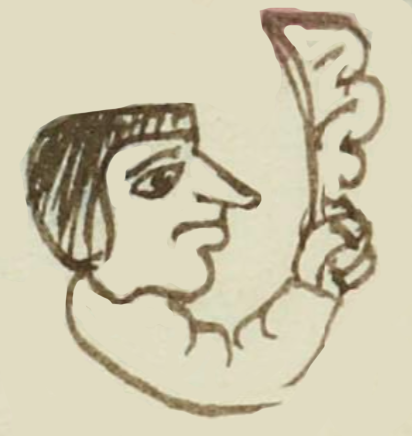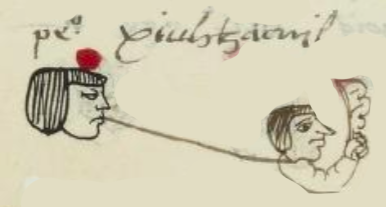Xiuhtzacuil (MH842v)
This black-line drawing of the simplex glyph for the personal name Xiuhtzacuil (perhaps a plant for creating a covering) is attested here as a man’s name. The glyph shows the upper body of a man in profile, facing right. In his left hand he holds up a large branch with what are probably large green leaves (xihuitl). Perhaps branches of greenery such as this one were used to build something to cover people (tzacuilli). If not, the -tzacuil part of the name requires further research. The person wears a shirt with a long sleeve. The sleeve has folds at the bent elbow, which give it three-dimensionality.
Stephanie Wood
A passage in the Florentine Codex (Book 7, folio 3 verso), referring to the “pyramids” of the Sun and Moon, reveals that both tzacualli and tzacuilli could refer to pyramids. (See: the Digital Florentine Codex, https://florentinecodex.getty.edu/book/7/folio/3v.) If tzacuilli refers to covering or enclosing something, originally referring to protection from wind, especially, perhaps when it was used for referring to a pyramid, it was with a thought to what was inside the pyramid, something covered up, such as a burial or an earlier pyramid.
Stephanie Wood
peo tzacuil
Pedro Tzacuil
Stephanie Wood
1560
Jeff Haskett-Wood
plantas, hojas, cosas verdes, protección, construcción, arquitectura, nombres de hombres

xihu(itl), herbs, green leaves, and turquoise, https://nahuatl.wired-humanities.org/content/xihuitl-0
tzacuil(li), something covered up or enclosed, a construction that offered protection; https://nahuatl.wired-humanities.org/content/tzacualli
posiblemente, Planta para Cubrir
Stephanie Wood
Matrícula de Huexotzinco, folio 842v, World Digital Library, https://www.loc.gov/resource/gdcwdl.wdl_15282/?sp=759&st=image.
This manuscript is hosted by the Library of Congress and the World Digital Library; used here with the Creative Commons, “Attribution-NonCommercial-ShareAlike 3.0 License” (CC-BY-NC-SAq 3.0).





